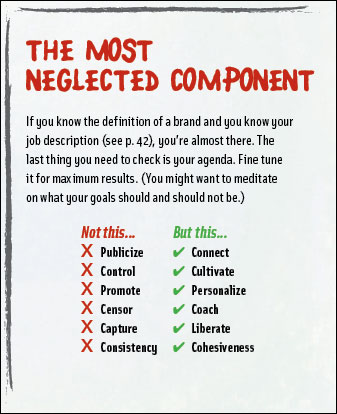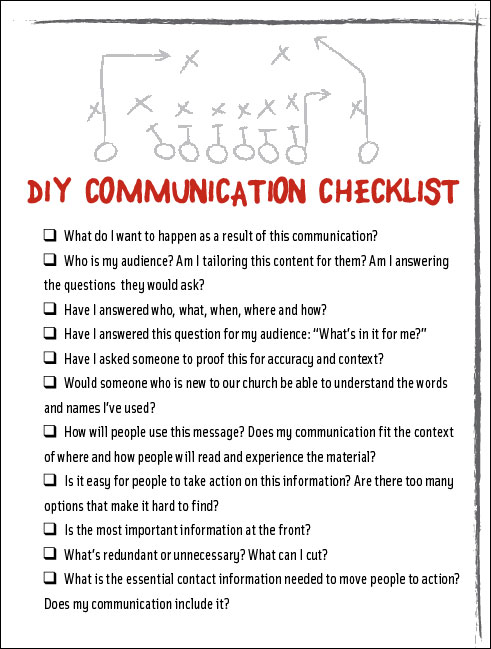
Communication is tricky—especially organizational communication. So many people are involved—on the inside and out. How do you communicate to help people take their next step toward Christ?
How do you cover all of the following objectives that are often thought of as required elements for effective communication?
INSPIRATION: information that motivates people to action.
OWNERSHIP: mission, vision and values across teams and locations.
INCLUSION: a common vocabulary for diversified audiences.
BALANCE: just enough, but not too much.
LONGEVITY: not just the here and now, but for the ongoing future.
These are loaded objectives, and we usually see two common responses to the challenges of meeting all five: Control everything or just give in to the free-for-all. Both approaches are counterproductive.
At this point, things could get complex if we let it. But we won’t. Simple approaches do exist. The best way to get there is to start right with a few essentials and to stay right with the right filter.
Start right with the right basics that apply to everyone.
A group of people with a clear understanding of the defined win can effectively create great work—easily. When everyone on the team collaborates to give it form, decisions are made and materials come together readily.
You, me—we are that group of people.But first we need to start with the same understanding of a key ingredient to our communication: the brand.
1. What is a brand? Given the right tools, a brand is like a person with good communication and adaptation skills. A brand is not a veneer you apply to make something pretty. Instead, a brand begins to exist when you have something to offer the world. It is a promise of what to expect. Great brands are trustworthy experiences. Think Nike, Apple, Star Wars.
2. How is a brand created, developed and maintained? Brands are created and developed by people with a shared philosophy. They shepherd the brand’s development, acting as the brand’s heart, head, eyes, hands, ears and voice. Everyone (and by that I mean everyone) who affects any brand touchpoint is responsible for making sure its values remain intact and understandable. Think brand handlers.
3. How does brand awareness grow? Brands need friends, or a support system, and again it comes back to people. Think brand advocates.
A communications hub team collects, prioritizes and edits the essentials of the brand, providing to all the handlers what they need to connect with people and the world. The systems they create allow the brand to adapt and be used in different ways.
Let’s review. Handle the brand with care. Don’t manhandle the brand.
Got it? Good. It’s as if you just graduated from the fastest branding school in the universe. Move your tassel and advance to the next section.
You have a new job description.
Now that you’ve graduated from brand school, it’s time to define your role as a brand handler. As promised, we’ll keep it simple.
It all boils down to three basic mantras: Love them. Own them. Live them. Everything else will fall into place. Remember these brand handler characteristics:
1. Your job is much more about releasing the right response than it is about sending the right message.
2. You vow to reduce information obesity and simplify complexity.
3. Your commitment to effective communication comes from a level of self-awareness that is more of an attitude than a skill. It comes not from technique, but from being genuinely interested in what really matters to the other person.
What are your values?
How we communicate with each other and our audience brings our values to life. By protecting these values, we’re able to help people take their next step toward Christ and each other. The win? To simplify everything our audience sees, to make their life easier and more rewarding in every interaction with our church and ministries.
Abide in these values like your own little personal quality control department:
- Clear. It’s not what you say; it’s what people hear. Remove distractions to simplify everything your audience sees or touches to help them effortlessly connect with Jesus and others. Eliminate the fluff and get to the point. Answer the essential questions: who, what, when, where and how.
- Portable. Put the mission within reach for everyone. Make it shorter, visual, specific, scannable, searchable and categorical.
- All Access. Easy to find. Easy to use. Easy to share. We use universal language and avoid insider jargon (and acronyms). We focus on the needs of our guests, not the needs of our ministries.
- Well Done. If it’s worth communicating, it’s worth getting it right. When you’re trying to enhance the experience and harness the power of a message, every detail and touchpoint matters, up front and behind the scenes.
- Guide. We use communications not as a final destination, but as an effective vehicle that helps people find their way from A to B. We treat our deliverables as way-finding tools that help people navigate their way to what’s next in the process, not everything at once. We draw people into the content we have to offer—allowing them to absorb and seek on their own terms.
- Whole. The whole is greater than the sum of its parts. We are a unified church working toward one common vision we all own, not a federation of sub-ministries working for our own agenda and goals. We don’t strive to be fair, but rather appropriate based on scope.
I hope this little guide has helped you tap into a fresh perspective, an encouraging nudge, a few “aha” moments and some uncomplicated strategies that make a noticeable difference in your church’s internal and external communication. Take advantage of all the tools you have here. Believe it or not, every form of your communication can be better, and your life will be easier. No, seriously. It will.
Kem Meyer is the communications director at Granger Community Church and author of Less Clutter. Less Noise.: Beyond Bulletins, Brochures and Bake Sales. You can find a full version of Granger’s Communication Playbook, as well as information about Meyer’s communication workshops and coaching networks, at WiredChurches.com. She blogs at KemMeyer.com.



Get Spirit-filled content delivered right to your inbox! Click here to subscribe to our newsletter.
Dr. Mark Rutland's
National Institute of Christian Leadership (NICL)
The NICL is one of the top leadership training programs in the U.S. taught by Dr. Mark Rutland. If you're the type of leader that likes to have total control over every aspect of your ministry and your future success, the NICL is right for you!
FREE NICL MINI-COURSE - Enroll for 3-hours of training from Dr. Rutland's full leadership course. Experience the NICL and decide if this training is right for you and your team.
Do you feel stuck? Do you feel like you’re not growing? Do you need help from an expert in leadership? There is no other leadership training like the NICL. Gain the leadership skills and confidence you need to lead your church, business or ministry. Get ready to accomplish all of your God-given dreams. CLICK HERE for NICL training dates and details.The NICL Online is an option for any leader with time or schedule constraints. It's also for leaders who want to expedite their training to receive advanced standing for Master Level credit hours. Work through Dr. Rutland's full training from the comfort of your home or ministry at your pace. Learn more about NICL Online. Learn more about NICL Online.


